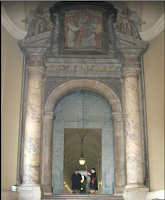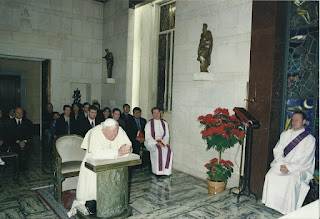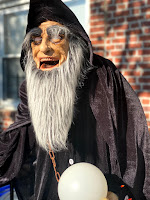"All is well that ends well"
Stones of Erasmus — Just plain good writing, teaching, thinking, doing, making, being, dreaming, seeing, feeling, building, creating, reading
26.11.20
Quote: John Heywood On Happy Endings (And Today is Thanksgiving in the United States of America!)
 I am an educator and a writer. I was born in Louisiana and I now live in the Big Apple. My heart beats to the rhythm of "Ain't No Place to Pee on Mardi Gras Day". My style is of the hot sauce variety. I love philosophy sprinkles and a hot cup of café au lait.
I am an educator and a writer. I was born in Louisiana and I now live in the Big Apple. My heart beats to the rhythm of "Ain't No Place to Pee on Mardi Gras Day". My style is of the hot sauce variety. I love philosophy sprinkles and a hot cup of café au lait.
17.11.20
Video Repost: Teen Entrepreneurs Start Their Own Trash Bin Cleaning Service Called The Wash Broz
 I am an educator and a writer. I was born in Louisiana and I now live in the Big Apple. My heart beats to the rhythm of "Ain't No Place to Pee on Mardi Gras Day". My style is of the hot sauce variety. I love philosophy sprinkles and a hot cup of café au lait.
I am an educator and a writer. I was born in Louisiana and I now live in the Big Apple. My heart beats to the rhythm of "Ain't No Place to Pee on Mardi Gras Day". My style is of the hot sauce variety. I love philosophy sprinkles and a hot cup of café au lait.
31.10.20
All Hallows' Eve in Greenwood Cemetery and Sunset Park, Brooklyn (Special 2020 Halloween Post)
In this post, I will regale you with pictures and musings from an All Hallows' Eve visit to Greenwood Cemetery and Sunset Park, Brooklyn. It was a beautiful Autumn Day and we are all cognizant of the need to physical-distance ourselves — so what better way to do that than to be outdoors in a massive cemetery?
Exploring Greenwood Cemetery on All Hallows’ Eve, I scored a handful of great photographs. Located in South Brooklyn, the cemetery is one of the oldest graveyards in the city and is a site of a Revolutionary War battle. @historicgreenwood is also a National Historic Landmark. My friends John and Jennifer joined me; we also went to Sunset Park, my old neighborhood. Scarfed down a torta stuffed with spicy pork at @tacoselbronco, scored a free beer from a passerby, and watched the D train come out of the tunnel on Fourth Avenue — it was a serendipitous day.


 I am an educator and a writer. I was born in Louisiana and I now live in the Big Apple. My heart beats to the rhythm of "Ain't No Place to Pee on Mardi Gras Day". My style is of the hot sauce variety. I love philosophy sprinkles and a hot cup of café au lait.
I am an educator and a writer. I was born in Louisiana and I now live in the Big Apple. My heart beats to the rhythm of "Ain't No Place to Pee on Mardi Gras Day". My style is of the hot sauce variety. I love philosophy sprinkles and a hot cup of café au lait.
25.10.20
On How To Meet a Pontiff (Or, That Day I Attended a Private Audience with John Paul II)

|
|
When I was a Roman Catholic Seminarian, and the very young age of nineteen, I was in a private audience with the then Pontiff of the Roman Catholic Church, John Paul II |
To say that I met and chatted with the leader of the Roman Catholic Church would be a stretch. But I did kiss his ring. And I got to see him in his private chapel and in his private library in the Vatican.
I attended a private audience with about twenty-five other people — mostly priests and seminarians. It was the year 2000—around Christmas time—and I was in Rome with other American seminarians from the American College in Leuven, Belgium (where I was a college seminarian at the Catholic University of Leuven). At the time I was studying to be a priest, and our group was invited to have a private audience. The story went that when John Paul II was a seminarian in Krakow, Poland, his seminary was suppressed by the Nazis and apparently, the American College, in Leuven, had sent over, secretly, supplies, books, and the sort, to Poland, as a sign of support and solidarity.
We were in Rome for two weeks, staying as guests at the Pontifical North American College (located on the Janiculum hill) — but we didn't know what day our audience would happen. There are security protocols one follows when scheduled to meet the Pope. The Vatican gave a call to our group leader, a Benedictine priest named Aurelius Boberek, the night before and he then contacted us to be on the ready. We're meeting the pope!

|
| The Bronze Doors |
The night I heard the message I had to scrap my plans for the following day. I was planning to visit the catacombs of Saint Callistus. Oh well, I thought, a papal visit trumps all of that. So we had to wake up early — to arrive at the Bronze doors of the Vatican Apostolic Palace at the crack of dawn. You enter the doors from the right colonnade in Saint Peter's Square. Once we were green-lit to proceed, we were inside the Apostolic Palace — which extends as a grand loggia, designed by the Renaissance artist Raphael. It serves as an official portal and links up with the jumble of buildings that comprise the palace.
John Paul II had a private chapel in the papal apartments, located in the upper floors of what is officially called the Palace of Sixtus V, where he celebrated an early mass. It was so quiet when we arrived one could hear a pin drop. The Pope enters the sanctuary fully vested and he celebrated the Mass in the old Latin rite style — facing the altar (and not facing the people). I think I read one of the readings for the Mass (Or, maybe I read the intercessions. I cannot remember, exactly). So did my classmate Brent Necaise, who was a student with me — I was from Louisiana and he was from Mississippi). Afterward, the Pope's private secretary, a fellow by the name of Stanislaus Dziwisz, escorted us to the private study (or was it the library?) of the Pope.
It was Christmas time, so in the Pope's library there was a stately Christmas tree with ornaments painted with images of John Paul II. I remember thinking that was funny for some reason. I guess if you are Pope you get used to seeing your image affixed to everything from postage stamps, money, and ornaments. I remember all of the furniture was elegant but not overstated. It was a brightly lit room. And there was a wooden barrister bookcase with nicely appointed leather-bound books.
The Pope entered shortly after we had congregated and took a seat in a white plush chair. Everyone in our group lined up to meet him one by one, by kissing his ring, and stating our home state in the United States. When it was my turn he said softly, "Oh. The Mardi Gras," because it was announced I was a seminarian from Louisiana, and when another seminarian said he was from Kentucky he said, "Oh. Race horses." And it went like that — and each of us received a rosary and a holy card.

|
 I am an educator and a writer. I was born in Louisiana and I now live in the Big Apple. My heart beats to the rhythm of "Ain't No Place to Pee on Mardi Gras Day". My style is of the hot sauce variety. I love philosophy sprinkles and a hot cup of café au lait.
I am an educator and a writer. I was born in Louisiana and I now live in the Big Apple. My heart beats to the rhythm of "Ain't No Place to Pee on Mardi Gras Day". My style is of the hot sauce variety. I love philosophy sprinkles and a hot cup of café au lait.
20.10.20
How Diligence Paid Off Cataloging Indigenous Plant Species of Louisiana (And How I Came Upon the Secret of Motivation)
In this post, I wax nostalgic about a class I took in high school and how it taught me something about human motivation.
"You'll need to collect one-hundred specimens of native flora from Louisiana to gain a perfect score for this project," intoned our Biology teacher — I was in Eleventh grade. I had opted to take a class called Biology II rather than Environmental Science. It was unlike me. Having gravitated more to the arts and humanities, even in high school, taking an advanced science class went against the grain. But it was one of the most immersive courses I took in high school. I liked the botany unit. We had an entire semester devoted to exploring indigenous plant species of Louisiana. I had even gone as far as to purchase a used copy of a field guide to plants of the state; "Don't collect invasive species," our teacher had said. So I wanted to make sure I knew the difference between Kudzu and an indigenous Wood Sorrel.
 |
| Look around you. There is a world to catalog and discover. |
What drives motivation? What made me so motivated to pursue a task that before I had taken it, I would never have followed on my own? Most likely, it was the challenge of the project. Something about discovery: and the idea that I had to explore areas outside the boundaries of my neighborhood or looked closely at the familiar. I don't remember what my classmates did for the project; I don't recall working with a partner.
I had my parents purchase for me a ginormous three-pronged binder and a bunch of styrene protective covers. To successfully save a plant specimen, it is necessary to place the plant parts into a book or under a newspaper fastened with something heavy — like a book or a rock. It can take days for the specimen to set properly — our teacher had specifically said that if you don't let the plant sufficiently dry out — it will rot and produce mold once you seal it in the binder covering. The first few plants I had picked out delivered such a fate — I didn't press them long enough — so afraid of having points deducted from my project, I did them over again.
I was diligent and methodical with this project — I managed to collect about ninety-eight specimens — everything from Sweet Bay Magnolia to a Pitcher Plant. I noticed how invasive species could completely take over an area, their massive and quick growth, quickly suffocating plant diversity in the area. This specific invasive plant called Chinese Privet — I found lots of those everywhere around my backyard. Seeing the ubiquity of certain herbaceous plants made me realize the destructive force of nature when human intervention is too rapid, and Mother Nature cannot keep up.
Motivation is tied to relevance. If you can tap into the significance of a task, then you have your student's attention. Make a task too easy, and it loses its relevance; make a task unattainable, and it becomes a chore. I like how my teacher implied that the project had a perennial aspect to it; I still have that binder from high school. And I still have the plant species; they are labeled correctly and nicely preserved.
It wasn't an easy task, but it promised discovery. So finding a rare plant species proved to me a gleeful moment — filled with joy, as on a particular jaunt into the woods behind my mother's house in Madisonville, Louisiana — I found a Devil's Walking Stick — properly named because if you pluck it you will automatically be stung by its many sharp prongs that line its length. Walking deep into the woods, I came across a bayou that flooded its waters often when rain fell heavily, which gradually seeped back into the ground or wended its way back to a tributary and then into the Tchefuncte River and then finally into Lake Pontchartrain, which is an estuary that opens out into the Gulf of Mexico. Everything is connected. I knew then and know now.
As a teacher myself, I now give students projects and written assignments, as one is wont to do as a teacher. I have never given out a botany project like the one my science teacher did for us — but I marvel at what motivated me to complete such a project so painstakingly. I sometimes joke with colleagues that if someone were to crack the code of what truly motivates people to be industrious, creative, or simply do work — especially work that at first glance does not seem necessary — they ought to win some kind of Nobel Prize for Ingenuity. I never went into Botany — heck, in college, I only took a handful of Science classes. The bulk of my undergraduate course load was filled to the brim with Dante and Kazuo Ishiguro — with ample servings of Plato, Aristotle, Thomas Aquinas and Shakespeare — can you tell I went to a heavily Western-centric liberal arts college? But I never forgot my foray into botany. That project stayed with me over the years. I still remember the scientific names of certain plant species — for example, Live Oaks and White Oaks — and all oaks — belong to the Quercus genus. And figs are in the ficus family. And if you take a walk with me in the woods, I will revel in the joy of discovering a field of Crimson Clover — it's still a beautiful flower.
 I am an educator and a writer. I was born in Louisiana and I now live in the Big Apple. My heart beats to the rhythm of "Ain't No Place to Pee on Mardi Gras Day". My style is of the hot sauce variety. I love philosophy sprinkles and a hot cup of café au lait.
I am an educator and a writer. I was born in Louisiana and I now live in the Big Apple. My heart beats to the rhythm of "Ain't No Place to Pee on Mardi Gras Day". My style is of the hot sauce variety. I love philosophy sprinkles and a hot cup of café au lait.
25.9.20
Street Photography: 74th Street in Jackson Heights, Queens (Plus Some Creative Writing)
A walk through Jackson Heights reveals crisp night air, Saturn and Jupiter in the sky, masked faces, lit-up trees, and the vibrancy of 74th Street.
What was supposed to be a walk to increase my daily steps turned into a journey. People pop out. Restaurants offer outside seating. The night is crisp. Saturn and Jupiter are still visible in the sky — on the way to convergence. I wanted to get more faces in my photographs. But the moments passed by too quickly. I saw a masked guy in a cab. He was balefully looking out a window. The Q49 bus runs along 74th Street. Wear your mask.
Today in class an adolescent pupil couldn’t answer a question — so she said to me, “This question makes me feel unsafe.” I was taken aback by her statement. It’s the Covid. I imagined her shrieking out of class. By an unsafe question. I’m teaching a course on mythology. And one characteristic of myth is the unknown. So I get it, girl. Stuff gets real. From chaos to calm. From the womb to the tomb.
 I am an educator and a writer. I was born in Louisiana and I now live in the Big Apple. My heart beats to the rhythm of "Ain't No Place to Pee on Mardi Gras Day". My style is of the hot sauce variety. I love philosophy sprinkles and a hot cup of café au lait.
I am an educator and a writer. I was born in Louisiana and I now live in the Big Apple. My heart beats to the rhythm of "Ain't No Place to Pee on Mardi Gras Day". My style is of the hot sauce variety. I love philosophy sprinkles and a hot cup of café au lait.
19.9.20
Travel Diary: Jones Beach in September (When Jupiter and Saturn Are Visible in the Evening Sky)
Where setting sun meets lapping waves — John, a friend, and colleague who is an amateur weather guy, tells me that the cloud formation in the sky is from weather pushing inland, effects of hurricane formation in the Atlantic, and today’s low dew point (which makes for a gorgeous day to be outside). Jupiter and Saturn are visible in the sky, and the moon is a thin crescent. Waves crash on shore — moving in a sweeping longitudinal motion. I almost get wet, and I marvel at the enthusiasm of seagulls. Which picture do you like best?
 I am an educator and a writer. I was born in Louisiana and I now live in the Big Apple. My heart beats to the rhythm of "Ain't No Place to Pee on Mardi Gras Day". My style is of the hot sauce variety. I love philosophy sprinkles and a hot cup of café au lait.
I am an educator and a writer. I was born in Louisiana and I now live in the Big Apple. My heart beats to the rhythm of "Ain't No Place to Pee on Mardi Gras Day". My style is of the hot sauce variety. I love philosophy sprinkles and a hot cup of café au lait.











